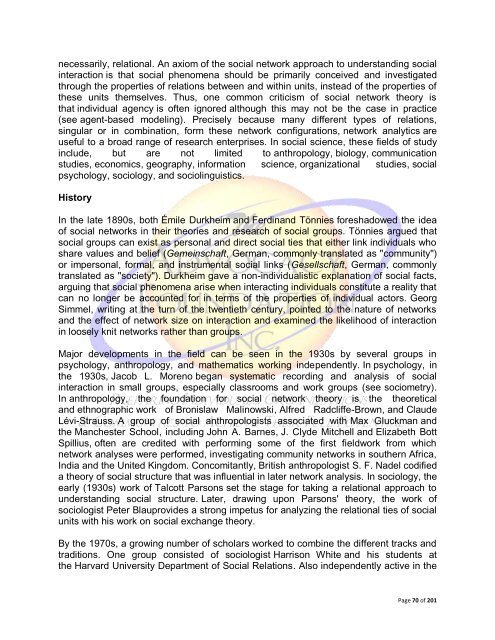ComeUnity CAPACITY BUILDING
ComeUnity CAPACITY BUILDING
ComeUnity CAPACITY BUILDING
You also want an ePaper? Increase the reach of your titles
YUMPU automatically turns print PDFs into web optimized ePapers that Google loves.
necessarily, relational. An axiom of the social network approach to understanding social<br />
interaction is that social phenomena should be primarily conceived and investigated<br />
through the properties of relations between and within units, instead of the properties of<br />
these units themselves. Thus, one common criticism of social network theory is<br />
that individual agency is often ignored although this may not be the case in practice<br />
(see agent-based modeling). Precisely because many different types of relations,<br />
singular or in combination, form these network configurations, network analytics are<br />
useful to a broad range of research enterprises. In social science, these fields of study<br />
include, but are not limited to anthropology, biology, communication<br />
studies, economics, geography, information science, organizational studies, social<br />
psychology, sociology, and sociolinguistics.<br />
History<br />
In the late 1890s, both Émile Durkheim and Ferdinand Tönnies foreshadowed the idea<br />
of social networks in their theories and research of social groups. Tönnies argued that<br />
social groups can exist as personal and direct social ties that either link individuals who<br />
share values and belief (Gemeinschaft, German, commonly translated as "community")<br />
or impersonal, formal, and instrumental social links (Gesellschaft, German, commonly<br />
translated as "society"). Durkheim gave a non-individualistic explanation of social facts,<br />
arguing that social phenomena arise when interacting individuals constitute a reality that<br />
can no longer be accounted for in terms of the properties of individual actors. Georg<br />
Simmel, writing at the turn of the twentieth century, pointed to the nature of networks<br />
and the effect of network size on interaction and examined the likelihood of interaction<br />
in loosely knit networks rather than groups.<br />
Major developments in the field can be seen in the 1930s by several groups in<br />
psychology, anthropology, and mathematics working independently. In psychology, in<br />
the 1930s, Jacob L. Moreno began systematic recording and analysis of social<br />
interaction in small groups, especially classrooms and work groups (see sociometry).<br />
In anthropology, the foundation for social network theory is the theoretical<br />
and ethnographic work of Bronislaw Malinowski, Alfred Radcliffe-Brown, and Claude<br />
Lévi-Strauss. A group of social anthropologists associated with Max Gluckman and<br />
the Manchester School, including John A. Barnes, J. Clyde Mitchell and Elizabeth Bott<br />
Spillius, often are credited with performing some of the first fieldwork from which<br />
network analyses were performed, investigating community networks in southern Africa,<br />
India and the United Kingdom. Concomitantly, British anthropologist S. F. Nadel codified<br />
a theory of social structure that was influential in later network analysis. In sociology, the<br />
early (1930s) work of Talcott Parsons set the stage for taking a relational approach to<br />
understanding social structure. Later, drawing upon Parsons' theory, the work of<br />
sociologist Peter Blauprovides a strong impetus for analyzing the relational ties of social<br />
units with his work on social exchange theory.<br />
By the 1970s, a growing number of scholars worked to combine the different tracks and<br />
traditions. One group consisted of sociologist Harrison White and his students at<br />
the Harvard University Department of Social Relations. Also independently active in the<br />
Page 70 of 201

















